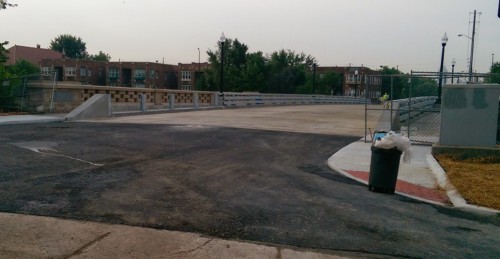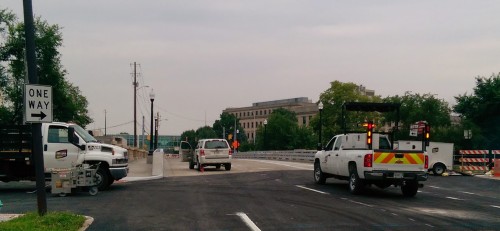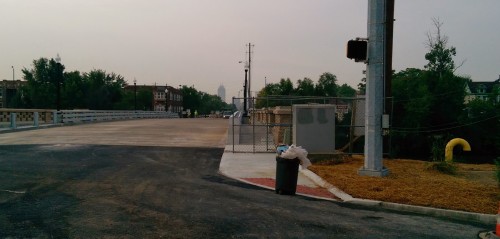Last summer, the City began work on a year-long project to replace the structurally deficient Illinois Street Bridge Over Fall Creek.  A similarly-long project took  place in 2012 to replace the eastern side of the Meridian Bridge and restore the limestone facade.  When it reopened, Urban Indy immediately reported on the woefully inadequate sidewalk replacement that was part of the project.  A $2.5M bridge replacement project was the perfect opportunity to correct the Meridian Bridge sidewalk width, but the Department of Public Works (DPW) totally whiffed on it and kept the original, marginal design width.
With the Illinois Bridge, it appears that DPW at least attempted to improve safety for pedestrians on the bridge by adding a safety rail and more light poles. Â While those enhancements are welcome, their implementation leaves us scratching our heads.
The bridge is still a construction zone, so you’ll have to forgive the long-distance photographs in this post, but consider this image showing the new, not-quite-complete safety rail:
I can’t fathom the decision-making that lead to this design being selected. Â There is zero recognition of the historic bridge facade in the safety railing material or design. Â Perhaps that doesn’t matter, since the railing is tall enough that it will effectively block anyone in a vehicle from ever seeing the historic bridge.
On a more fundamental level, one could also argue that a safety rail to separate pedestrians from vehicles is only necessary because the bridge is intrinsically unsafe for pedestrians.  Might it have been wiser to address the underlying issue rather than the side-effect?  For example, reducing vehicle lane widths would have the dual effect of slowing down cars and providing additional area for sidewalks, a protected bike lane or cycle track, or possibly even a small strip of landscaping (yes, it’s possible to
landscape a bridge).
Looking at the original bridge still visible
on Google Streetview, there were originally just three wood pole-mounted lights. Â Now there are at least six aesthetically pleasing (if faux-historic) lights, a significant improvement for the safety of pedestrians. Â However, moving slightly to a view in-line with the sidewalk, we see a problem:
Yes, the new light poles are mounted directly onto the sidewalk.  Given that both the rail and light poles were brand-new design elements in this replacement bridge, it seems obvious that the poles could have been integrated into the new safety rail in order to eliminate any obstructions to the sidewalk.
Sadly, with anything new at DPW, it always seems to be two steps forward, one step backwards.



That safety rail design should have been made more historic looking to tie in with the design of the bridge. If there were renderings of the design prior to the plans being submitted we The Meridian Highland Neighborhood Association missed the boat on that.
Hopefully they won’t make the same mistakes when they redo The Capitol Avenue Street Bridge.
It’s the DPW…it’s almost a guarantee they will make the same mistakes again.
Even INDOT does it better. Here’s a Google Street View of the recently-built separated side path along the 146th St. bridge over the US31/Keystone Parkway area:
https://www.google.com/maps/@39.999992,-86.128379,3a,75y,163.29h,102.08t/data=!3m4!1e1!3m2!1sgKT6uVn0D4nbpwy6GqBGSg!2e0?hl=en
Note that the “mini-Jersey Barrier” (with safety rail on top) would protect pedestrians and cyclists against most road spray and debris, and it even matches the bridge rail on the other side of the path!
1. How did they ever get that rail system past the State Historic Protection Office and National Park Service? This bridge is part of a National Register Historic Site (the Kessler parks and greenways system), and if DPW spent even one Federal road dollar, it would have had to meet historic preservation standards. That steel rail is seriously ugly…and it achieves the trifecta by also blocking the view and offering zero splash protection.
2. With the (unfortunately, all-too-usual) lamppost-in-sidewalk, it looks as if the effective sidewalk width is only marginally ADA compliant. I’m sure that it’s probably just-compliant…but I agree with Chris. The posts could have been integrated into the rail system. Clearly two people couldn’t walk side by side past the lampposts.
That’s two for two on head-slaps and D+ (just barely passing) grades for the bridge rebuilds. I wonder how what DPW will do to Capitol and Central?
The trifecta of not respecting the historic bridge design, blocking view of the bridge and not blocking road splash makes you wonder what, exactly, their goal was with the railing, right?!
If they were just worried about pedestrians walkways directly adjacent to fast-moving traffic, there are tons of examples of that around downtown.
Are the over-head electric wires incorporated into the bridge? While they aren’t visible in the pictures, it’s not clear whether that’s temporary or permanent. If permanent and replaced with underground (or in this case within the bridge), then that’s a nice improvement. But it doesn’t make up for the rail design and the lightpost placement.
This is embarrasing. I def will not waste any time on this one.
“Might it have been wiser to address the underlying issue rather than the side-effect? For example, reducing vehicle lane widths would have the dual effect of slowing down cars and providing additional area for sidewalks, a protected bike lane or cycle track, or possibly even a small strip of landscaping (yes, it’s possible to landscape a bridge).”
Or, you know, make it two-way. Can anyone give me even a slightly acceptable reason to have Illinois be one-way that far north? And if anyone says “move more traffic” I’m going to go ballistic. There is never enough traffic that far north and there is little to no evidence that one-way pairs move more traffic than a pair of two-ways. Not to mention they are proven to be less efficient over all.
“Sadly, with anything new at DPW, it always seems to be two steps forward, one step backwards.”
Whether or not you got “forward” and “backward” in the right place in this sentence could be the subject of vigorous debate.
Actually I did have a vigorous internal debate about forward/backward steps, but decided to give DPW a little credit for at least acknowledging a problem, even if their solutions are very poorly implemented. 😉
You might be interested in this thread: http://plan2020.mindmixer.com/ideas/130686/better-streets-for-neighborhoods-less-focus-on-commuters
From the comments:
On a purely personal level, this bridge project has been insane. I live at 21st & Meridian, where all the traffic from Illinois has been routed, with most people opting to go to Meridian. This has made it nearly impossible to make a left turn onto 21st out of my apartment. This project was supposed to be done December 31st!!!! Plus, traffic got even worse when the work began on the 21st street exits to 65. I will be SO happy with this is done, though the fact that they added a full 8 months on to finish it, it seems like they could have designed something better.
Nick – I live just a little north of you and can confirm the clusterfuck that 21st has turned into. What I’ve observed is that the north-south streets in the area have readily absorbed the diverted traffic from Illinois, while the Illinois –> Meridian cross-connections at 18th, 21st and 22nd have been absolutely crushed under the increased load.
Certainly the connector streets weren’t built for this and don’t need to be. Mercifully, 21st will be back to normal soon. But it seems pretty clear that there’s a ton of excess capacity in the north-south streets through the near north neighborhoods if we can shut down Illinois for a year with hardly a hiccup on Meridian, Delaware, and College.
All that said, I never saw anything that said the bridge project would be completed in December. The DPW project sheet linked in the first sentence of the post is dated 6/20/13 and says “Summer 2013 to Summer 2014.” That’s all I’ve ever seen.
This feels like bait. 🙂
The previous rebuild on Meridian seriously backed up traffic, so I don’t think you can say capacity can be removed without a hiccup. I’ll admit I haven’t been sitting 25 feet from Meridian while Illinois has been closed, but I find it hard to believe that Meridian isn’t seriously congested from 3-5:30pm between 21st and Fall Creek, and between 30th and 38th.
I’m hard-pressed to explain the difference. The lane closures associated with the Meridian bridge work had a more significant effect on traffic backing up on Meridian than the total closure of Illinois has had.
I drive up Meridian every evening rush hour from Methodist Hospital to a school north of the Parkway and this was my experience today:
Illinois free-flowing but 21st was fully clogged and backed up down Illinois so I kept going to 22nd
22nd was also fully clogged and backed up down Illinois
It took 3 light cycles to get across 22nd to turn north onto Meridian
Meridian free-flowing all the way to a red light at the Parkway, stopped in traffic about 2/3rds of the way back on the bridge (cars continued to back up behind me)
That’s a bit better than average. Except when an accident is causing havoc in the system, traffic typically backs up to somewhere around 24th, or maybe to 23rd.
I’m not a traffic engineer, but here’s a guess about why the backups have been different:
The Meridian bridge is a finely-tuned machine that efficiently directs traffic to the Parkway and continuing north on Meridian. It’s dangerous to pedestrians but can handle a traffic load significantly higher than it typically sees. Diverted traffic from the recent closing of Illinois? No problem!
On the other hand, the Meridian bridge work in 2012 didn’t fully close that bridge. Instead, they closed lanes, which induced dysfunction in the traffic system near the Parkway. And because the bridge wasn’t totally closed, most commuters still chose to use it. VOILA! Crazy backups.
(I must admit that this theory does lend credence to your thoughts about how important Meridian is as an alpha street and shouldn’t be used for mass transit.)
I will admit that when heading northbound during the Meridian work, I did sometimes jog from Meridian over to Illinois (by way of little-known alleys to avoid the no left turn restrictions on Meridian) to avoid the mess at Fall Creek.
Your supposition makes some sense.
OK, I can’t resist the transit discussion.
Yes re Red Line off Meridian. Rapid transit needs to be, well, rapid. It’s amazing that so many blog posters complain about the “high speed” one-ways and then completely ignore the advantage such streets offer for BRT.
BRT should stay on a one-way pair from 38th to Downtown. Meridian is well-served by the 38/39 IndyGo buslines.
Chris,
They changed the document. I became irritated late last year about the backup, and I went up and looked online. It said it would be done December 31st. I was somewhat relieved and thought I could keep my sanity for that long. When New Years came and went, I went back up to the same site, and the deadline had changed to the current wording. I was livid.
I’m all for being angry at DPW, but I simply don’t believe this is true. I track these project sheets from DPW and they never say something as specific as “December 31st” for a completion date. Take a look at the ones currently posted:
http://www.indy.gov/eGov/City/DPW/RebuildIndy/Projects/Pages/MajorProjectFactSheetsandLinks.aspx
The partial replacement of the Meridian Bridge in 2012 took 10 months. It’s not believable that DPW would have projected a full replacement of the Illinois Bridge could have been completed in 6 months.
There is a buffered bike lane on Illinois. It would have made perfect sense to integrate the buffered lane barrier into the new bridge railing and also widen it for pedestrian access.
Also, nothing will happen to how fast cars bomb up Illinois so it’s really a moot point since so few people will feel comfortable walking along here or riding their bike on the street anyway.
Placebo….
The bridge design is terrible. Typical DPW garbage. Nothing more to say there.
But regarding traffic and one-way vs two-way: as has been said, if you can close Illinois completely for a year or more, and traffic on Meridian isn’t extremely congested, how could anyone argue that traffic couldn’t be handled adequately if both Illinois & Capitol each had one lane northbound with occasional turn lanes as needed? That would be two more northbound lanes that we’ve survived with for the last year or so.
One can argue that we should keep them as high-speed one-ways so that some drivers can enjoy faster travel times, but I really don’t think there should be any debate as to whether they’re needed to prevent traffic congestion. I was a little surprised that DPW didn’t implement temporary changes to detour Illinois traffic over to Capitol to get across the bridge. Instead, they implicitly conceded that there is no true need for a multi-lane, one-way Illinois Street.
The “wild card” is the Red Line BRT, Paul.
What seems proven is that the “high speed one way pair” doesn’t need as many lanes…and one could easily be used for BRT.
An alternate suggestion to Chris C. above is that traffic “west of center” from north to south can relatively easily jog over to MLK or even I-65 to get downtown. So I suspect that some of the traffic to/from IUPUI, IUHealth’s various facilities, Simon building, and the State Government Center may have actually detoured west. Only MPO and DPW know for sure…if they even did surveys.
I see you are channeling your inner-Urbanophile ala his “If you can close the 65/70 split for months at a time multiple times in a decade, do you really need it?”
All in all, I guess I’m not sure why the default is “let’s leave it the way it is” instead of “let’s change this for a bit and if it is really that bad, we’ll change it back.” It smacks of laziness and CYA.
I say change them to two ways and assuming the apocalypse doesn’t occur, leave them. Central seems to be fine where they’ve turned it two way. Anyone heard major whining about that?
I think the default is to “don’t spend money unnecessarily,” a sign of the times.
There is a non-trivial cash and work time outlay in changing a street from two way to one way and vice versa. It’s more than just removing and repainting lines, as signals and signs all have to be added, removed, and changed.
If in an era of constrained budgets the choice is more maintenance or more changes in configuration, then I am for more maintenance.
And, of course, for re-doing the Kessler Fall Creek bridges properly…unlike the last two.